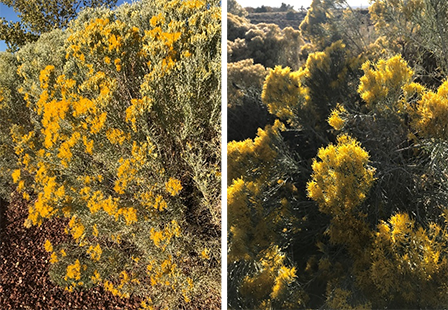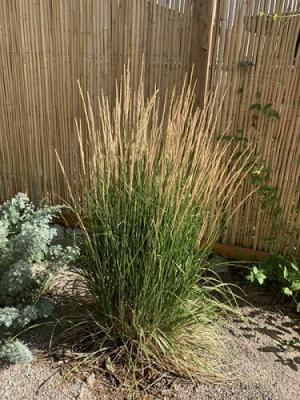November 13, 2021
Care for Ornamental Shrubs and Grasses:
Okay to Prune Lightly Now, but Save Major Cuts for Late Winter
Question:
Our chamisa was glorious this year, but it is very leggy. Should I prune it back, and if so, how much? I haven’t pruned grasses either, and wonder if that is also something that I should do (feather grass, giant sacaton).
- Barbara G., Albuquerque
Answer:
From the plant health perspective, the biggest reason not to prune grasses and small shrubs too early is that the extra material provides a layer of protection from cold damage. If you cut back too much now, lower branches (called the “crown” in grasses) and roots are more likely to be damaged this winter. Two other excellent reasons to wait: 1) foliage and seedheads add beauty and textural interest to the winter landscape, and 2) they support overwintering pollinators by providing habitat and nesting materials. As described in the Xerces Society guidebook Attracting Native Pollinators, “Different species of butterflies and moths use different strategies to survive the winter or other extended periods of inclement weather. Most species pass the winter as eggs, caterpillars, or pupae in protected surroundings such as leaf litter or dense vegetation.”

That being said, if leggy branches and grass stems are out of control and in the way, consider pruning back a little now and pruning more heavily in late March, as needed. This advice holds for many common shrubs and grasses in New Mexico landscapes, including roses, butterfly bushes, salvias, snowberry, rose of Sharon, and lavender. Ideally, these plants are placed strategically so that annual pruning isn’t necessary.
Big Caveat: Some species (like lilacs) should be pruned just after they bloom in the spring. If pruned dramatically in late summer, fall, or winter, you’re likely to have fewer flowers—maybe even no flowers at all. Other examples include winter jasmine, forsythia, Spanish broom, and wisteria.
Bernalillo County Extension Horticulture Agent Sara Moran collected recommendations from local experts to address the needs of each species listed in this week’s question:
Chamisa (Ericameria nauseosa): “Regular pruning will promote health, provide air circulation, and maintain a desirable shape by removing dead or damaged branches. Pruning is best done in late-winter to early spring before new growth appears. Pruning in deep winter can weaken the plant and eventually kill it. The simplest pruning technique is to shear the entire plant back by about one-quarter to one-third its total height, making a rounded shape. ‘Renewal’ pruning occasionally—once every few years or so—can be achieved by cutting back harder, up to one-half or more of the total plant size. Do not do this yearly or you will shorten the plant life span." - Susan Brunen, from the Santa Fe Botanical Garden website.

Feather reed grass (Calamagrostis arundinacea): “Cut leaves down close to the ground in early spring to remove weathered foliage and rejuvenate established plants. To maintain a more manicured look, trim off seed heads whenever they start to look weathered.” - From New Mexico Gardener’s Guide by Judith Phillips
Giant sacaton (Sporobolus wrightii): “To keep it looking great, cut it to the ground in early spring to remove last year’s dead leaves." - Shalene Hiller, from Plant Select. Plant Select® is a nonprofit collaboration of Colorado State University, Denver Botanic Gardens, and professional horticulturists.
I tend toward minimal pruning in my much-loved, albeit messy, garden. This past spring, I attempted a mini trial by cutting three of my eight ‘Blonde Ambition’ blue grama grass clumps down to a height of about 8 inches above the ground and left the others fully intact. Checking back now, I don’t think you could tell which ones I pruned—I can barely tell myself. Luckily, I have photos to help me remember. It is worth noting that later in the summer, the pruned plants looked much greener and showier than their shaggy chic counterparts. To see the pics, visit the Desert Blooms blog version of this column. (Disclaimer: At the time they were taken, I was trying to capture hummingbird activity, not specifically tracking my mini trial progress, so the quality of said photos is mediocre at best.)
Speaking of landscape manicure confessions, Judith Phillips also recommends combing off the matted seed heads of thread grass with a fine rake or steel-toothed grooming comb. So in June 2020, I may have purchased a pair of stainless steel salon-grade scissors with teeth advertised for thinning hair, alleviating excess weight, softening lines, and blending between sections. Is that what Phillips had in mind for controlling gnarled grass seeds? Probably not. Did it work? Kind of. The result looked quite a bit better than my previous year’s impatient hack job, but it took way more time. What my fancy method lacked in efficiency it made up for in fun and avoiding what I’ve come to call “shear boredom.”
Join the gardening webinar team for “Home Composting” at 3 pm on Wednesday, November 17 via Zoom with John Zarola, Outreach Coordinator for the Bernalillo County Extension Master Composters program! Find us at Ready, Set, GROW!
Marisa Y. Thompson, PhD, is the Extension Horticulture Specialist, in the Department of Extension Plant Sciences at the New Mexico State University Los Lunas Agricultural Science Center, email: desertblooms@nmsu.edu, office: 505-865-7340, ext. 113.
Links:
For more gardening information, visit the NMSU Extension Horticulture page at Desert Blooms and the NMSU Horticulture Publications page.
Send gardening questions to Southwest Yard and Garden - Attn: Dr. Marisa Thompson at desertblooms@nmsu.edu, or at the Desert Blooms Facebook page.
Please copy your County Extension Agent and indicate your county of residence when you submit your question!